Lesson 8: Australia’s Symbols
Introduction
Symbols are powerful representations of a nation’s identity, values, and heritage. In Australia, various symbols have been adopted to reflect the country’s rich history, diverse culture, and natural beauty. This lesson explores the key national symbols of Australia, including its coat of arms, national animal, flower, colors, and more. These symbols not only embody Australia’s identity but also serve as reminders of its unique place in the world.
The Coat of Arms
The Australian Coat of Arms is the official symbol of the Commonwealth of Australia, granted by King George V in 1912. It represents the federation of the Australian states and the country’s authority and government.
- Design and Features:
- Shield: At the center of the Coat of Arms is a shield divided into six sections, each containing a symbol representing one of the six states of Australia. These include:
- New South Wales: The Cross of St. George with a lion and stars.
- Victoria: The Southern Cross with a crown.
- Queensland: A Maltese Cross with a crown.
- South Australia: A piping shrike (a local bird).
- Western Australia: A black swan.
- Tasmania: A red lion passant.
- Crest: Above the shield is a gold Commonwealth Star with seven points, representing the unity of the six states and territories.
- Supporters: Flanking the shield are a kangaroo and an emu, two of Australia’s most iconic animals. These animals were chosen because they are native to Australia and are believed to be unable to move backward, symbolizing the country’s progress and forward-thinking.
- Wattle: A spray of golden wattle, Australia’s national flower, appears at the base of the Coat of Arms, representing the nation’s natural beauty and flora.
- Significance:
The Australian Coat of Arms is a symbol of national pride and authority. It is used on official documents, government buildings, and Australian currency. The symbols within the Coat of Arms reflect Australia’s history, its states, and its unique wildlife, making it a powerful representation of the nation’s identity.
The National Animal: Kangaroo
The kangaroo is one of Australia’s most recognized and beloved national symbols. It appears on the Coat of Arms, the currency, and various logos, representing the country’s unique wildlife and its spirit of resilience and strength.
- Significance:
The kangaroo is native to Australia and is known for its ability to cover vast distances and move rapidly, which symbolizes progress and moving forward. The kangaroo’s prominence as a national symbol reflects Australia’s connection to its natural environment and its distinctive wildlife.
The National Bird: Emu
The emu, like the kangaroo, is a native Australian bird and is also featured on the Coat of Arms. The emu is the largest bird in Australia and the second-largest bird in the world by height.
- Significance:
The emu symbolizes perseverance and the ability to overcome challenges, as it is known for its speed and resilience. Alongside the kangaroo, the emu’s inability to move backward represents the idea of national progress and the forward momentum of the Australian people.
The National Flower: Golden Wattle
The golden wattle (Acacia pycnantha) is Australia’s national flower, chosen for its hardiness and widespread presence across the country. The golden wattle blooms with bright yellow flowers, particularly in late winter and early spring.
- Significance:
The golden wattle symbolizes unity and resilience, qualities that are highly valued in Australian society. The flower’s bright yellow color has also influenced Australia’s national colors. Wattle Day is celebrated on September 1st each year, marking the beginning of spring and honoring this national symbol.
The National Colors: Green and Gold
Australia’s national colors, green and gold, are derived from the colors of the golden wattle. These colors have become synonymous with Australian identity and are used in various contexts, including sports uniforms, national events, and official symbols.
- Significance:
Green and gold symbolize the natural beauty of Australia, particularly its landscapes and flora. These colors are a source of pride for Australians and are instantly recognizable in international settings, particularly in sports where Australian teams are known as “The Green and Gold.”
The National Gemstone: Opal
The opal is Australia’s national gemstone, known for its stunning play of colors. Australia is the world’s leading producer of opals, with the majority of the world’s supply coming from the country.
- Significance:
The opal is a symbol of Australia’s natural wealth and its connection to the land. The gemstone’s vibrant colors are often seen as a reflection of the diverse and colorful landscapes of Australia, from its deserts to its coastal regions.
The National Anthem: “Advance Australia Fair”
“Advance Australia Fair” is the national anthem of Australia, officially adopted in 1984. The anthem was composed by Peter Dodds McCormick in 1878 and reflects themes of unity, progress, and national pride.
- Lyrics and Significance:
The lyrics of “Advance Australia Fair” celebrate the country’s freedom, natural beauty, and the spirit of the Australian people. The anthem is performed at official events, national celebrations, and sporting occasions, serving as a unifying song that embodies the values and aspirations of the nation.
Other National Symbols
- National Flag: The Australian National Flag, with its Union Jack, Commonwealth Star, and Southern Cross, is the primary symbol of Australia’s sovereignty and identity.
- Australia’s National Day: Australia Day, celebrated on January 26th, is the national day of Australia, marking the anniversary of the First Fleet’s arrival in 1788.
Conclusion
Australia’s national symbols are deeply embedded in the country’s identity, reflecting its history, culture, and natural environment. From the kangaroo and emu to the golden wattle and opal, these symbols represent the unique characteristics that make Australia distinctive. Understanding these symbols helps Australians and others appreciate the values, history, and pride that these emblems embody.

